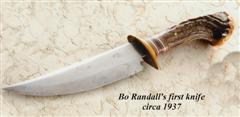No problem Capt Chris. Very good suggestion. I was playing on your title Capt. As in "an order from the Captain." Nothing at all implied. Trying to keep it light:-)
As to the civil part, I am always civil. I have all the respect in the world for everyone in this forum. This is all about the facts. I have never, nor will I ever take it personal.
With that being said, I will also not let sideways references to my opinion go unnoticed. Joes "haunting" statement brought me back into this.
If you bring JRB's with you that are in this gray 60-63 area Cap, then bring provenance that ties it absolutely to Johnson.
You are in a predicament Cap. On the one hand you support Gary Randall's claim that Heiser never had a stamp. I totally understand that loyalty. Its from the top.
But then we have the obvious problem that Gary also stated that he did not find Maurice Johnson until 1962. Rut-Roh! If ya believe that also, then ya have to explain who made all those hundreds of sheaths from 60-62.
We already have Gary Clinton's provenance knives dating to 1960 that have the west and horizontal stamp, with serif numbers, with no edge bevel.
Where is the provenance that Johnson made west or horizontal sheaths with serif numbers and edge bevel?
If you intend to show me RMK sheaths that are west or horizontally stamped, with serif numbers, with no edge beveling, I think you will have a most difficult time convincing me that it is a Johnson.
Its all about the visible handmade traits Cap.
Heiser used their traditional heiser stamp oriented horizontally, as they always had, then they oriented the new RMK stamp horizontally, then changed to vertical west facing. All the while, using serif number stamps. Joe lays this out in his timeline.
An added feature not included in Joe's timeline, is the edge beveling. After Heiser quit using the throat rivets for strength, they began using a 1/2" reinforcement stitch at the throat. At that time, it seems that they quit doing the front face edge bevel.
Moving forward, Heiser/HKL continued this tradition of serif number stamps and no front edge beveling on their west and horizontal stamped sheaths.
Johnson,when he started, distinguished himself as a sheath maker by orienting his stamp east, used no number stamp, then used non serif number stamps, and beveled the edge as Moore did.
Why wouldn't he want to have his sheaths distinguishable? He was a leather worker. A professional.
What you and Joe are asking me to believe is that:
1) Johnson absolutely clones Heiser sheaths, right down to the the stamp orientation, serif number stamps, and no edge bevel.
2) Johnson wakes up one day after making a few hundred or thousand sheaths, decides then, and only then to turn the stamp?
Guys, that part is totally logical. What is not logical to me is that he has been using perfectly good serif number stamps, has been saving time and labor by not edging the front of the sheaths. Then he decides on a whim to spend money to change the style of the number stamp, and spend that extra manufacturing time to edge the front of the sheath????? Why, may I ask? What is the logic?
What is logical to me is that Heiser/HKL made west and horizontal sheaths in the same manufacturing tradition that they had been using for years.
Johnson, from the beginning,wanted his sheaths to be distinguished, changes the orientation to east, uses non serif number stamps as he may have had already, and bevels the edge as Moore, another Florida sheath maker had done.
I guess you and Joe would have me believe that the differences, like cowhide thickness, leather tone, mottling, thread color, stitch tightness will convince me otherwise?
I don't think so. And here is why.
Saddle makers may traditionally get their cowhide from a single source, but the suppliers get their hides from different places around the country, depending on availability.
Stitch count? We see variables with both makers.
Leather tone? Leather tone changes over the years, especially if the owner of the knife may have conditioned the leather.
Mottling? Can't speak to that yet, but I will.
Too fuzzy for me. Too many variables that can be observed with both makers.
What's not fuzzy, is the intentional way that the makers made the sheaths. The stamps, the edge beveling.
Heck, I haven't even covered the reinforcement stitch. Heiser was all over the place on that one. Both stitches inside, both stitches outside, one inside, one outside, on the Heisers. The Heiser/HKL's display that too.
The East facing Johnson sheaths, thus far seem to be all inside reinforcement stitch, making it safer to bevel the front edge. Smart I think, and logical.
I know this is pretty long winded, but I am trying to make it all as crystal clear as I have found the evidence so far.
Good luck trying to change my mind. It will take proof, not opinion.
_________________________
Sam Granade
RKS Member #5700





